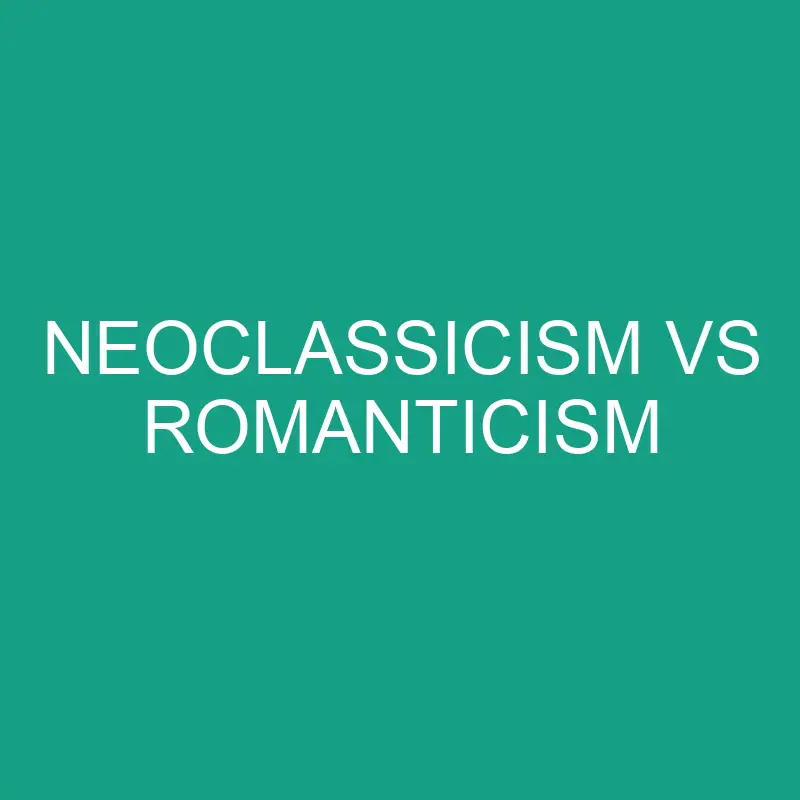Neoclassicism and Romanticism are two major movements in art, literature, and culture that emerged in the late 18th and early 19th centuries. While they share some similarities, they differ in their values, styles, and subject matter. In this article, we will define both terms, provide examples, and discuss the similarities and differences between them, as well as the pros and cons of each.
Post Contents
Neoclassicism:
Neoclassicism is an artistic and cultural movement that emerged in the 18th century, inspired by the art and culture of ancient Greece and Rome. Neoclassical art emphasizes rationality, order, and symmetry, often featuring classical subjects such as gods, heroes, and historical events.
Example: Jacques-Louis David’s painting “The Death of Socrates” is a classic example of Neoclassical art, featuring a scene from ancient Greek philosophy.
Pros: Neoclassical art and culture emphasize rationality, order, and balance, providing a sense of stability and clarity in an uncertain world.
Cons: Neoclassicism can be seen as cold, impersonal, and lacking in emotion, as it tends to prioritize reason over passion.
Romanticism:
Romanticism is an artistic and cultural movement that emerged in the late 18th century, emphasizing emotion, imagination, and individualism. Romantic art often features dramatic and exotic subject matter, such as landscapes, nature, and the supernatural.
Example: William Wordsworth’s poem “I Wandered Lonely as a Cloud” is a classic example of Romantic literature, featuring a description of a natural landscape and the poet’s emotional response to it.
Pros: Romantic art and culture emphasize individualism, emotion, and creativity, providing a sense of freedom and authenticity in an increasingly industrialized and commercialized world.
Cons: Romanticism can be seen as overly sentimental, escapist, and unrealistic, as it tends to prioritize emotion over reason.
Similarities Between Neoclassicism and Romanticism
Both Neoclassicism and Romanticism emerged in response to the cultural and social changes of their time, emphasizing different values and ideals. Both movements also had a significant impact on art, literature, and culture, shaping the way we think about these fields today.
Difference Between Neoclassicism and Romanticism
The main difference between Neoclassicism and Romanticism lies in their values and styles. Neoclassicism emphasizes rationality, order, and symmetry, often featuring classical subjects and balanced compositions. Romanticism, on the other hand, emphasizes emotion, imagination, and individualism, often featuring dramatic and exotic subject matter and expressive compositions.
Comparison Table:
| Neoclassicism | Romanticism |
|---|---|
| Emphasizes rationality, order, and symmetry | Emphasizes emotion, imagination, and individualism |
| Often features classical subjects and balanced compositions | Often features dramatic and exotic subject matter and expressive compositions |
| Values clarity, balance, and objectivity | Values subjectivity, creativity, and authenticity |
| It can be seen as overly sentimental, escapist, and unrealistic | Can be seen as overly sentimental, escapist, and unrealistic |
| It can be seen as cold, impersonal, and lacking in emotion | Provides a sense of freedom and authenticity in an increasingly industrialized and commercialized world |
Neoclassicism Vs Romanticism Literature:
Neoclassical literature, which emerged in the 18th century, emphasized reason, order, and logic, often drawing on classical themes and motifs. Writers of this period focused on objective, rational arguments and avoided emotional or subjective content. In contrast, Romantic literature, which emerged in the late 18th century and peaked in the 19th century, emphasized emotion, individualism, and imagination. Romantic writers explored the inner life of characters and emphasized subjective experience, often using unconventional or supernatural elements.
Example: Alexander Pope’s “An Essay on Man” is a classic example of Neoclassical literature, while William Wordsworth’s “I Wandered Lonely as a Cloud” is a classic example of Romantic literature.
Passion: Neoclassical or Romantic?
While Neoclassical art and culture emphasized reason and order over emotion, Romanticism placed a strong emphasis on passion and individual experience. While Neoclassical art might depict classical themes in a restrained and rational manner, Romantic art might feature intense emotions and a sense of personal expression.
Neoclassicism Vs Romanticism Art:
Neoclassical art, which emerged in the mid-18th century, emphasized rationality, balance, and order, often drawing on classical motifs and subjects. Neoclassical art often featured idealized figures in harmonious compositions, and the subject matter was often inspired by classical mythology, history, and literature. In contrast, Romantic art, which emerged in the late 18th century and peaked in the mid-19th century, emphasized emotion, individualism, and the sublime. Romantic art often depicted dramatic landscapes, violent scenes, and supernatural subjects, and emphasized the expression of personal emotion and experience.
Example: Jacques-Louis David’s painting “The Oath of the Horatii” is a classic example of Neoclassical art, while Caspar David Friedrich’s painting “Wanderer Above the Sea of Fog” is a classic example of Romantic art.
Neoclassical and Romantic Period:
The Neoclassical period, which spanned from the mid-18th century to the early 19th century, was characterized by a focus on reason, order, and classical motifs. Neoclassical art, literature, and culture emphasized rationality and clarity, often drawing on classical mythology, literature, and history for inspiration. The Romantic period, which spanned from the late 18th century to the mid-19th century, was characterized by a focus on emotion, individualism, and the sublime. Romantic art, literature, and culture emphasized personal experience and imagination, often featuring unconventional or supernatural elements.
In conclusion, Neoclassicism and Romanticism were two major artistic and cultural movements that emerged in the 18th and 19th centuries. While they share some similarities, they differ in their values, styles, and subject matter. Neoclassicism emphasized reason, order, and classical motifs, while Romanticism emphasized emotion, individualism, and the sublime. Both movements had a significant impact on art, literature, and culture, shaping the way we think about these fields today.
Summary:
Neoclassicism and Romanticism are two major movements in art, literature, and culture that emerged in the late 18th and early 19th centuries. While they share some similarities, they differ in their values, styles, and subject matter. Neoclassicism emphasizes rationality, order, and symmetry, often featuring classical subjects and balanced compositions. Romanticism, on the other hand, emphasizes emotion, imagination, and individualism, often featuring dramatic and exotic subject matter and expressive
